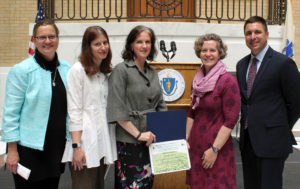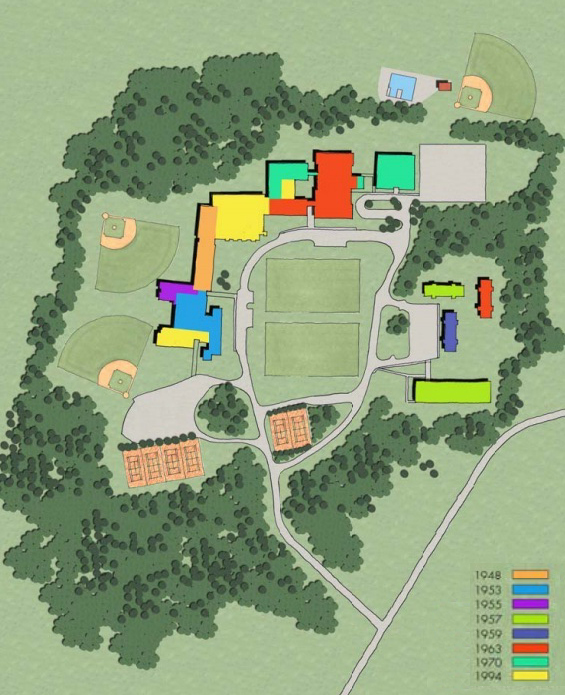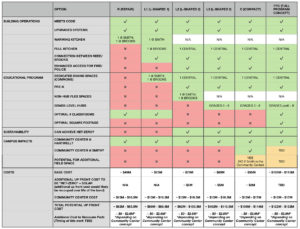Mothers Out Front is a nonprofit organization with chapters around the United States committed to preserving a livable planet for future generations. Our Lincoln chapter has closely followed the School Building Committee process over the past year. We applaud the committee on their diligence in considering the educational goals for the project as well as critical planning for sustainability in design and operation of the school. These two values were cited as the two most important values in a survey of the Lincoln community at the beginning of the planning process.
The process is reaching an important milestone with the June 9 meeting, where the committee will ask the town to endorse a general building design for further development by the architects. Mothers Out Front sees this as a watershed moment which will influence the success of our school, our educators, and our students for the next 50 years. It is also an exciting opportunity for Lincoln to express its commitment to a stable and safe climate future, a commitment which has never been more critical.
We believe the design known as “Compact C” best meets Lincoln’s dual goals of a flexible, high-quality, and innovative school campus which can also operate on a net zero basis for energy consumption. “Net zero” refers to a building (home, school, or commercial) where the total amount of energy used by the building on an annual basis is roughly equivalent to the amount of renewable energy created on the building and its site. A net zero building eliminates the need to burn fossil fuels and thus eliminates carbon emissions (or purchase of energy generated in another state at unknown expense, freeing the town from future concerns of fluctuating energy prices).
The net zero goal is achieved through design features including compact design, improved insulation, a tight building envelope, natural light, and heating and cooling with highly efficient ventilation systems. Like Mass. Audubon’s new net zero education center, net zero at the Lincoln school would be achieved through the installation of solar photovoltaic (PV) panels on the building and adjacent to the building, to produce the energy for the school. The Lincoln campus has the space needed on roofs, parking lots, and adjacent lands (if needed) to accommodate the school’s energy needs. This plan would also be compliant with Article 40, the town’s Facilities Energy Performance Standard passed in 2011.
The Compact C design has many advantages for the students, teachers, and campus as a whole, and is the preferred design by the majority of educators. The Compact C design eliminates wasted space in hallways and allows for more time in the classroom or time spent on educational activities versus navigating long hallways. The Compact C building footprint also allows for an additional playing field, which benefits the whole community. Compact C includes the most desirable educational spaces, including hub spaces for grades 3–8. And a compact building improves energy efficiency by reducing the ratio of building envelope to internal volume, an important feature to consider over the next 30 years of operations.
A very strong and compelling second choice is the L3 option. It includes the hub spaces and other important educational amenities, and can also include the net zero/solar panels design. The disadvantages of L3 are the loss of the additional playing field, longer transition times for students navigating the building, and a less energy-efficient design.
While we believe the advantages of the net zero design are compelling from the point of view of reducing future catastrophic impacts from climate change, there are sound economic arguments as well. The energy markets of the future defy easy predictions in terms of cost escalation and volatility. A robust solar installation on the campus locks in stable, predictable energy costs for the next 30 years. Consider that the school spends approximately $220,000 currently on annual utility bills that cannot be spent for the core educational mission. Over the next 30 years, this expense will total at least $6.6 million. If a net zero design is built, the town will begin recovering the cost of the net zero elements on the first day the school is operational.
With the vote on June 9, we believe the town of Lincoln has an exciting opportunity to achieve 21st-century educational and sustainability goals with the design of the new school building. We feel that Compact C (our first choice) and L3 (our second choice) with net zero both advance the town’s educational goals and our town’s vision for a fossil-fuel free future. Please join us on June 9 to vote for a state-of-the-art teaching and learning environment for the next generation of Lincoln students.
Sincerely,
Mothers Out Front Lincoln — Lincoln (Trish O’Hagan, Emily Haslett, Staci Montori, Robyn Bostrom, and Sheila Dennis







